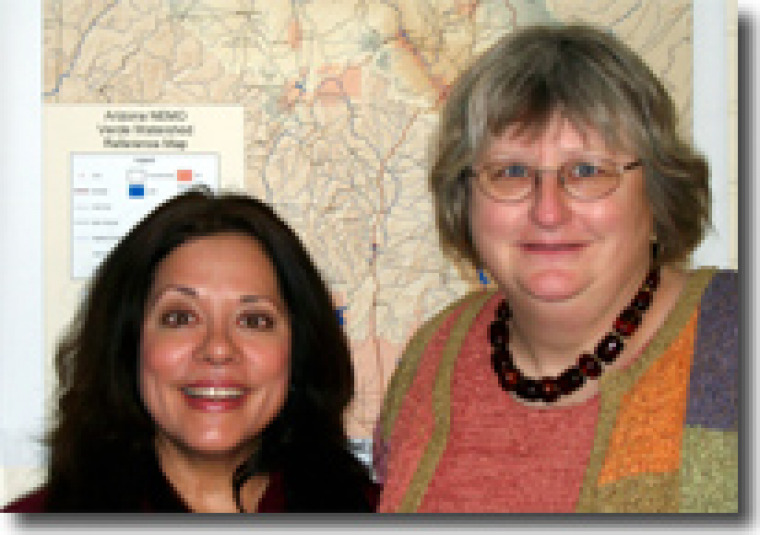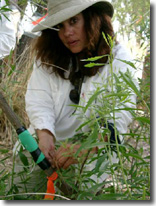Roberta McGuire

Roberta McGuire, co-sponsored by the Agricultural Research Service and the University of Arizona School of Natural Resources
Fall 2004
Water is a precious resource in our semiarid region and is in short supply. Land use decision makers need to be kept informed of hydrologic specifics and developments in our state and the impacts of their decisions upon our watersheds.
Currently I am involved with Kristine Uhlman (pictured right), the Statewide Coordinator for the Nonpoint Source Education for Municipal Officials (NEMO), an outreach education partnership between the University of Arizona Cooperative Extension and the Arizona Department of Environmental Quality. The NEMO program provides water education to land-use decision makers, municipalities, and other stakeholders to promote restoration, maintenance, and protection of water quality and quantity in watersheds across the state of Arizona.
Central to this program is the use of GIS mapping and modeling which provide visual displays of potential impacts of land use decisions upon water quality and quantity. In addition, we have been conducting hydrologic modeling to simulate impact to watershed response due to land use change, as well as ranking and prioritizing subwatershed areas for grant funding based on vulnerability to water quality degradation. Major watersheds that have been presented are the Bill Williams, Upper Gila and Verde River. We are currently extending the program to other regions of the state. Visit our site at www.srnr.arizona.edu/nemo and learn more about water quality conditions in these watersheds; recommendations for control of pollution sources; and suggestions for management options to protect and improve water quality in our state.
Spring 2005 Update
The condition and quantity of water supplies within rural Arizona are now considered a critical problem. These non-metropolitan communities have already experienced such rapid rates of population growth that existing water supplies and financial resources may be unable to sustain projected future growth. Current estimates by the Arizona Department of Economic Security anticipate a doubling of populations in these areas over the next 50 years. Essentially rural areas have limited water supply alternatives and even more inadequate planning information.
In my education outreach project, I am working with Kristine Uhlman, the Statewide Coordinator for the Nonpoint Source Education for Municipal Officials (NEMO), a program conducted in association with the University of Arizona Cooperative Extension and the Arizona Department of Environmental Quality. The Arizona NEMO program provides water education information to land-use decision makers, municipalities, tribal entities, and other stakeholders to promote restoration, maintenance, and protection of ground water and surface water quality and quantity in rural watersheds across the state of Arizona. This information is presented to all interested parties involved, through town hall meetings and community workshops with additional material also available on our website: http://www.srnr.arizona.edu/nemo
To help encourage active participation in rural watershed planning, my goal is to expand my work with Arizona NEMO through exploration of existing ground water resources available in rural communities. My work continues by incorporating water well data of state rural watersheds onto Arizona NEMO’s website, and assisting in the capacity of liaison between Arizona NEMO and local community town hall meetings, workshops and newspapers. I will work to inform community watershed groups and all interested parties of issues surrounding rural ground water availability and rural water needs. A major concern for rural watershed groups and land managers is the lack of available information on existing ground water resources.
Since our inception in 2004, I have been involved in developing a database of scientific research information, which provided background material to support an active rural watershed education outreach program. This information combined with NEMO maps has been utilized by existing watershed groups and has gained substantial interest and support for Arizona NEMO from rural communities in our state. Jan Holder, program manager of the Upper Gila Watershed Partnership has indicated that Arizona NEMO maps will help the Upper Gila Watershed group learn evaporation and transpiration rates. Knowing these rates will help to evaluate how much water will be available for Graham and Greenlee residents in the future.
We were instrumental, as part of a collaborative effort, in providing resource information to the Upper Gila Partnership that aided in the production of the first draft of a watershed plan and report. We are looking forward to working with the additional watershed groups of the Community Watershed Alliance in the Middle San Pedro Area and Wilcox watershed areas.
As a NASA Space Grant Graduate Fellow, I will continue to work with Kristine Uhlman of Arizona NEMO and become more actively involved in town-hall meetings with regional stakeholders, tribal entities, and community watershed groups to inform and illustrate how this information may be accessed and used for their water planning needs. Additional community workshops will be conducted in these rural areas to discuss and explore assessment of rural ground water supply conditions in relation to rural water needs.
We will continue to encourage participants at these community meetings to exchange contact information and develop their own network infrastructure of information exchange on water supply issues. Town hall meetings will offer an excellent opportunity to encourage individual participants to assume leadership-like roles. These individuals will then be provided with information to host/facilitate additional group meetings on building community support for their own water supply education programs.
My research work for my masters and doctorate both focus upon ground water use characteristics of native riparian versus invasive species along the lower, middle and upper San Pedro River basin areas. I plan to share the results of both my studies and other related research projects to be used as a tool for rural watershed planners in preparing water assessment budgets and preservation of riparian habitats. My work with Arizona NEMO and rural communities has been personally rewarding and I look forward to another year of furthering scientific knowledge of ground water conditions in rural areas and provide needed information and support that will allow all stakeholders and decision-makers involved to make responsible water use choices.
Fall 2005 Update



